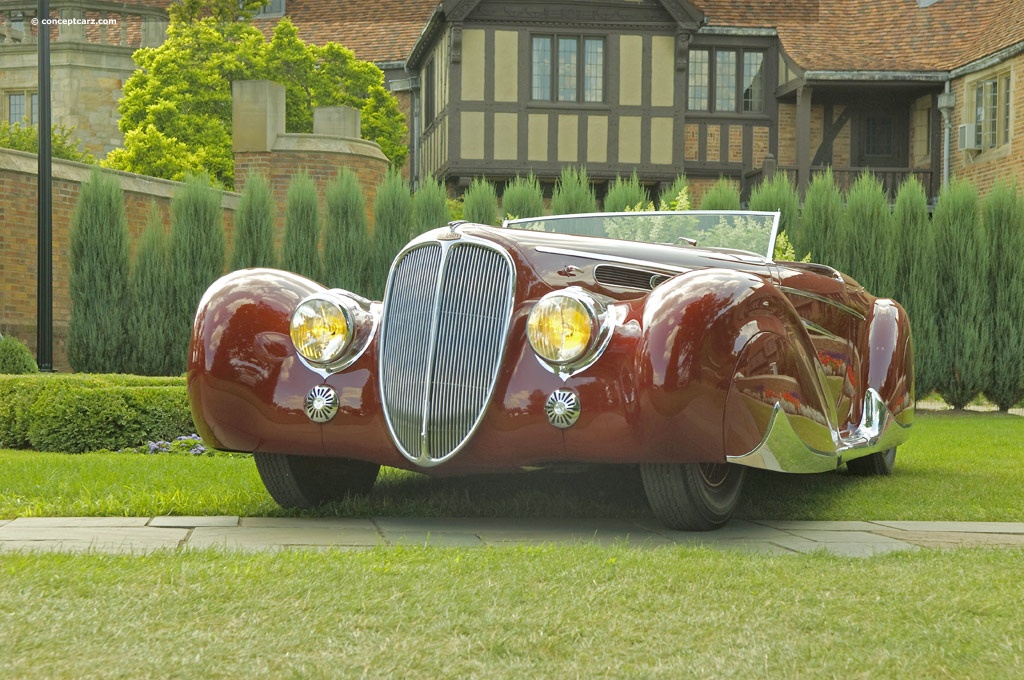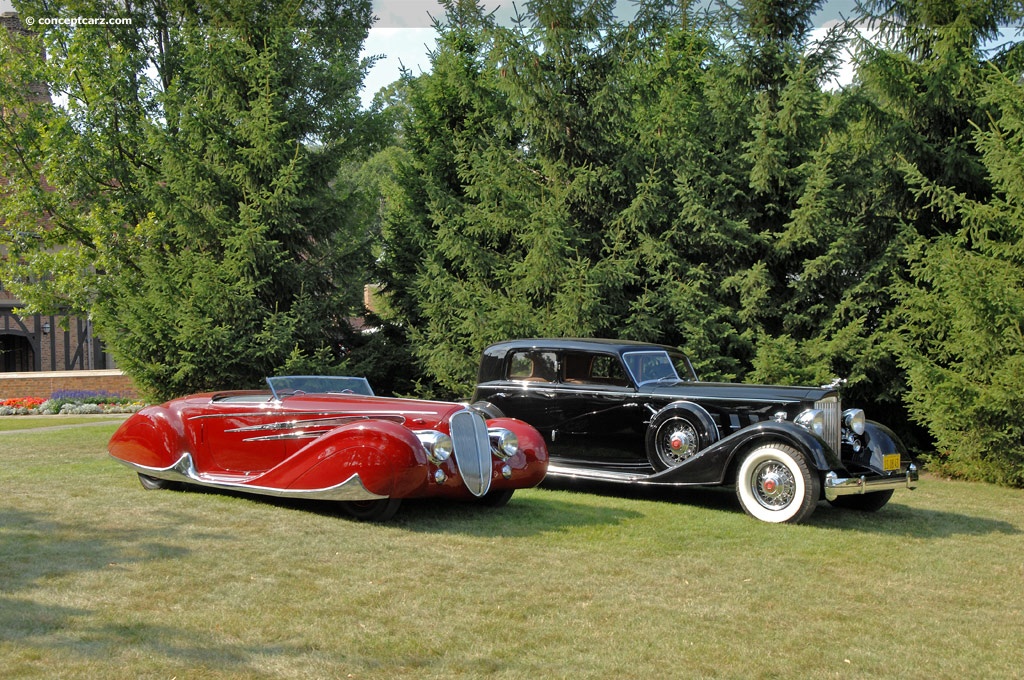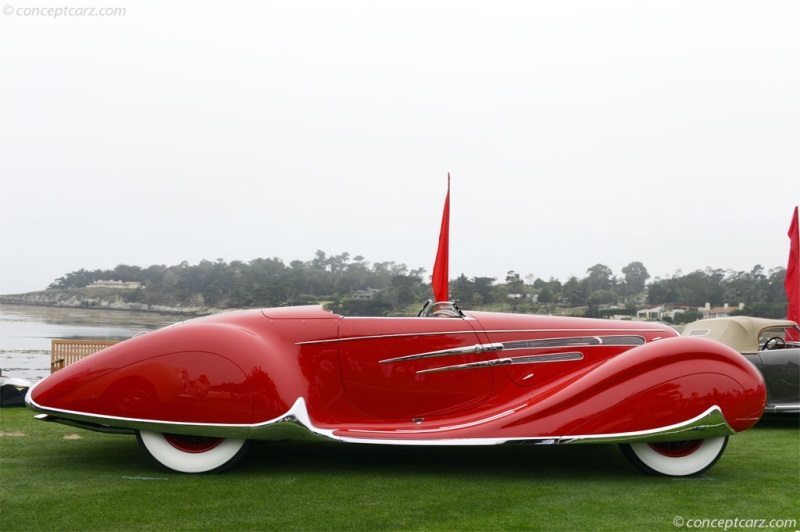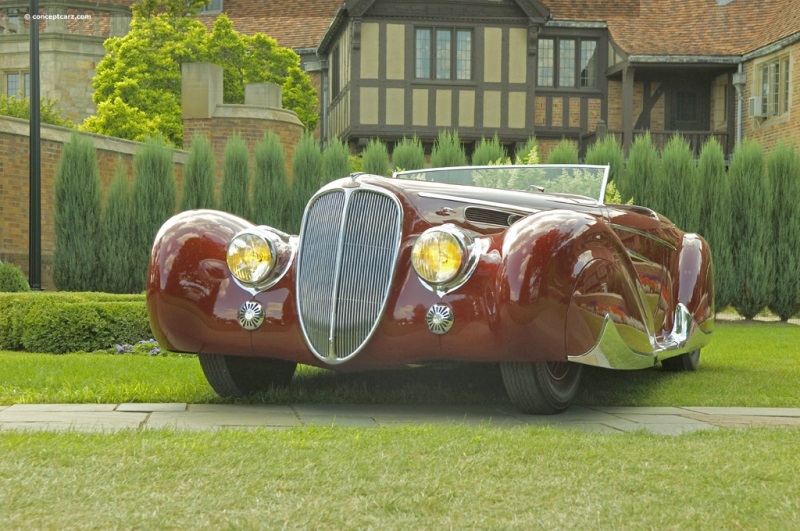1939 Delahaye Type 165 Navigation
Emile Delahaye was born in Tours, France in 1843. He studied engineering in Angers, France. In 1869, he began work with his engineering degree in applied arts and crafts.
Emile Delahaye began business in Tours, France in the middle of the 19th century to construct engines for the ceramic industry. The company branched out and began constructing mechanical appliances such as pumps and engines. In 1888, Delahaye designed an internal combustion engine for the shipping industry. It was not until 1896 that Automobile production began for Delahaye. His first automobiles produced were powered by belt-driven single and twin-cylinder engines.
Emile used motor racing to promote his vehicles. In 1896, Emile Delahaye entered the Paris-Marseilles race. Not only did he enter a vehicle his company had created, but he entered as the driver. The results were astounding, which truly speaks highly of the caliber and quality of the automobile. The demand for the vehicles began pouring in, and a second factory was opened.
Due to failing health, Delahaye was forced into retirement in 1901. This was a year after the second factory was opened in Paris. Since Delahaye had no heirs, management control was passed onto a young engineer named Charles Weiffenbach. Weiffenbach oversaw operations until 1954.
In 1905, due to failing health, Emile Delahaye passed away.
Automotive racing was paramount during this period in history. This is why many of the vehicles built during this era were built to be raced and to be used as the daily driver. The sales of the vehicles were stimulated by the way the vehicle performed on the race track. Weiffenbach, however, had a different philosophy. His main focus and priority were to build dependable vehicles. Many of the early vehicles were equipped with four-cylinder engines capable of producing between 9-12 horsepower. Near the beginning of the First World War, a 6-cylinder, 2565cc engine was used.
In addition to automobiles, the Delahaye company produced trucks, lorries, parcel carriers for the post office, motor plows, fire engines, and other commercial and military vehicles. Many of the vehicles were used during the First World War.
From 1927 to 1933, production of medium-class cars was low, but the vehicles that were produced carried with them a reputation for being reliable and robust.
In the early thirties, Weiffenbach, also known as 'Monsieur Charles' by his peers, was in his early 60's. The decision was made to boldly move into the sports car arena. This was in response to the market trends and a way to re-establish a competitive edge in the automotive technology spectrum. For an automotive company that had never created a car that could achieve a top speed faster than 110 km/h, this would be a major undertaking.
Jean Francois, a 29-year-old engineer, was commissioned to construct a series of sporty cars using as many of spare parts as possible. Talbot's new independent suspension was used along with a new chassis with box-section side members. The engine was borrowed from one of their trucks. The engine featured a 65mm crankshaft with internal lubrication. In 1933, the vehicles were introduced at the Paris Car Salon. They were the 4-cylinder 12CV and the 6-cylinder 18CV. At the show, Lucy O'Reilly Schell approached Weiffenbach with a request to have a vehicle built that could be entered in rally events.
Lucy O'Reilly, a wealthy American with Irish origin, had a passion for racing. So fueled by Delahaye's desire to produce sports cars and Reilly's financial backing and quest to win motorsport events, the company re-entered the racing scene.
Delahaye Type 135
The Type 135 was created with variants such as the 135 Competition Speciale (135 CS), designed specifically for racing. The 135 Sport and the 135 Coupe both featured a 3.2-liter engine. The Sport produced 96 horsepower while the Coupe had 110 horsepower. 120 horsepower was produced by the 3.6-liter engine that rested in the Type 135 Competition model. The engine in the 135 CS was a simple pushrod-operated engine borrowed from the 1927 Type 103 truck engine. It gave up horsepower for great acceleration and torque.
The Type 135 is considered one of the most famous and prestigious vehicles produced by Delahaye. In both design and racing competitions, it was very successful. Designed in 1934 it was quickly entered into races such as the 24 Heures du Mans, the Monte-Carlo Rally, and the Paris-Saint-Raphael motor race, where it had great success in being a competitive and reliable automobile.
The Type 135 Competition Speciale Sports Car (CS) had a chassis 25 cm shorter than the 135 touring car. This shortened version had better weight distribution, which greatly improved the handling and performance. The engine and 4-speed Wilson epicyclic gearbox were placed lower in the chassis, thus contributing to the benefits of a better-balanced vehicle. The 135 CS came equipped with an 80-liter or a 100-liter fuel tank, this option was left up to the buyer's discretion.
The 135 CS debuted in the 1936 Monte Carlo Rally, where it finished 2nd in a field of fierce competition. In 1936, it won the Marseilles Grand Prix. At the French Grand Prix it placed second, third, fourth, and fifth.
Well-known coachbuilders, such as Franay, Letourner & Marchard, Chapron, and Guillore, were tasked with outfitting the 135's. This may have been influenced by Delage, an automotive company that Delahaye merged with, in 1935. As a result, the 135 won numerous awards for styling and design.
The Type 135's is truly a prestigious masterpiece with a strong racing history and a heritage that was formed on stability, robustness, and stamina.
Figoni was an Italian immigrant who had changed his name to Joseph after arriving in France. In 1935, he began working with another Italian designer named Ovidio Falaschi. In 1936, they built the Delahaye 135MS roadster for the Paris Salon. The vehicle was based on drawings by the automobile artist Geo Ham. This design brought the duo instant success and recognition.
Delahaye Type 165
The Delahaye Type 165 was also designed by Guiseppi Figoni and Falaschi and was built for the 1937 Paris Salon. It was constructed on a Type 145 racing chassis and equipped with a 4.5-liter, triple overhead cam, aluminum, twelve-cylinder engine with a trio of downdraft Solex carburetors. A crank handle under the dash was used to remove the retractable windshield, where it would disappear down to the cowl.
Roadster
Chassis #: 60744
View info and historyOnly two examples of the Delahaye Type 165 were constructed.
by Daniel Vaughan | May 2009
Emile Delahaye began business in Tours, France in the middle of the 19th century to construct engines for the ceramic industry. The company branched out and began constructing mechanical appliances such as pumps and engines. In 1888, Delahaye designed an internal combustion engine for the shipping industry. It was not until 1896 that Automobile production began for Delahaye. His first automobiles produced were powered by belt-driven single and twin-cylinder engines.
Emile used motor racing to promote his vehicles. In 1896, Emile Delahaye entered the Paris-Marseilles race. Not only did he enter a vehicle his company had created, but he entered as the driver. The results were astounding, which truly speaks highly of the caliber and quality of the automobile. The demand for the vehicles began pouring in, and a second factory was opened.
Due to failing health, Delahaye was forced into retirement in 1901. This was a year after the second factory was opened in Paris. Since Delahaye had no heirs, management control was passed onto a young engineer named Charles Weiffenbach. Weiffenbach oversaw operations until 1954.
In 1905, due to failing health, Emile Delahaye passed away.
Automotive racing was paramount during this period in history. This is why many of the vehicles built during this era were built to be raced and to be used as the daily driver. The sales of the vehicles were stimulated by the way the vehicle performed on the race track. Weiffenbach, however, had a different philosophy. His main focus and priority were to build dependable vehicles. Many of the early vehicles were equipped with four-cylinder engines capable of producing between 9-12 horsepower. Near the beginning of the First World War, a 6-cylinder, 2565cc engine was used.
In addition to automobiles, the Delahaye company produced trucks, lorries, parcel carriers for the post office, motor plows, fire engines, and other commercial and military vehicles. Many of the vehicles were used during the First World War.
From 1927 to 1933, production of medium-class cars was low, but the vehicles that were produced carried with them a reputation for being reliable and robust.
In the early thirties, Weiffenbach, also known as 'Monsieur Charles' by his peers, was in his early 60's. The decision was made to boldly move into the sports car arena. This was in response to the market trends and a way to re-establish a competitive edge in the automotive technology spectrum. For an automotive company that had never created a car that could achieve a top speed faster than 110 km/h, this would be a major undertaking.
Jean Francois, a 29-year-old engineer, was commissioned to construct a series of sporty cars using as many of spare parts as possible. Talbot's new independent suspension was used along with a new chassis with box-section side members. The engine was borrowed from one of their trucks. The engine featured a 65mm crankshaft with internal lubrication. In 1933, the vehicles were introduced at the Paris Car Salon. They were the 4-cylinder 12CV and the 6-cylinder 18CV. At the show, Lucy O'Reilly Schell approached Weiffenbach with a request to have a vehicle built that could be entered in rally events.
Lucy O'Reilly, a wealthy American with Irish origin, had a passion for racing. So fueled by Delahaye's desire to produce sports cars and Reilly's financial backing and quest to win motorsport events, the company re-entered the racing scene.
Delahaye Type 135
The Type 135 was created with variants such as the 135 Competition Speciale (135 CS), designed specifically for racing. The 135 Sport and the 135 Coupe both featured a 3.2-liter engine. The Sport produced 96 horsepower while the Coupe had 110 horsepower. 120 horsepower was produced by the 3.6-liter engine that rested in the Type 135 Competition model. The engine in the 135 CS was a simple pushrod-operated engine borrowed from the 1927 Type 103 truck engine. It gave up horsepower for great acceleration and torque.
The Type 135 is considered one of the most famous and prestigious vehicles produced by Delahaye. In both design and racing competitions, it was very successful. Designed in 1934 it was quickly entered into races such as the 24 Heures du Mans, the Monte-Carlo Rally, and the Paris-Saint-Raphael motor race, where it had great success in being a competitive and reliable automobile.
The Type 135 Competition Speciale Sports Car (CS) had a chassis 25 cm shorter than the 135 touring car. This shortened version had better weight distribution, which greatly improved the handling and performance. The engine and 4-speed Wilson epicyclic gearbox were placed lower in the chassis, thus contributing to the benefits of a better-balanced vehicle. The 135 CS came equipped with an 80-liter or a 100-liter fuel tank, this option was left up to the buyer's discretion.
The 135 CS debuted in the 1936 Monte Carlo Rally, where it finished 2nd in a field of fierce competition. In 1936, it won the Marseilles Grand Prix. At the French Grand Prix it placed second, third, fourth, and fifth.
Well-known coachbuilders, such as Franay, Letourner & Marchard, Chapron, and Guillore, were tasked with outfitting the 135's. This may have been influenced by Delage, an automotive company that Delahaye merged with, in 1935. As a result, the 135 won numerous awards for styling and design.
The Type 135's is truly a prestigious masterpiece with a strong racing history and a heritage that was formed on stability, robustness, and stamina.
Figoni was an Italian immigrant who had changed his name to Joseph after arriving in France. In 1935, he began working with another Italian designer named Ovidio Falaschi. In 1936, they built the Delahaye 135MS roadster for the Paris Salon. The vehicle was based on drawings by the automobile artist Geo Ham. This design brought the duo instant success and recognition.
Delahaye Type 165
The Delahaye Type 165 was also designed by Guiseppi Figoni and Falaschi and was built for the 1937 Paris Salon. It was constructed on a Type 145 racing chassis and equipped with a 4.5-liter, triple overhead cam, aluminum, twelve-cylinder engine with a trio of downdraft Solex carburetors. A crank handle under the dash was used to remove the retractable windshield, where it would disappear down to the cowl.

Roadster
Chassis #: 60744
View info and history
by Daniel Vaughan | May 2009
- 1939 Delahaye Type 165 Menu
- Article
- Image gallery
- Specifications
- Production figures
Delahaye
Similar Vehicles
Similar Automakers
1939 Delahaye Type 165 Vehicle Profiles
Recent Vehicle Additions
Performance and Specification Comparison
Related Automotive News

1939 Delahaye Type 165 Cabriolet Wins Best In Class At 72nd Pebble Beach Concours d'Elegance
The Mullin Automotive Museums standout vehicle was also recognized as a finalist for Best of Show
The Mullin Automotive Museums 1939 Delahaye Type 165 Figoni et Falaschi Cabriolet was awarded Best in Class at the 72nd Pebble Beach Concours...

From pioneers to performance greats: Salon Privé unveils stellar entry for Concours d'Elégance
More than 100 years of motoring history on show at Blenheim Palace
Awards will be decided by ICJAG panel of world-leading experts and chief automotive designers
Coachbuilt beauties entered, along with competition legends on two wheels and four
Cl...

The 42nd Annual Concours d'Elegance Of America
The 42nd annual Concours dElegance of America at the Inn at St. Johns was a celebration of art, design, and technology by showcasing a diverse array of classic, rare and magnificent automobiles. Over two hundred of the worlds most spectacular contributions...

The Narval Design by Figoni et Falaschi
One of their most flamboyant and artistic Figoni et Falaschi designs was the Narval or Narwhal, based upon the Delahaye 135M chassis and introduced at the 1946 Salon de Paris. It was named Narval for its prominent front treatment, like a Narwhal...

Concours d'Elegance of America : Best of Show
image0
The 38th Concours dElegance of America displayed over 300 of the worlds most spectacular contributions to automotive history. This year, the event paid tribute to many special features inclduing Ford GT-40s, Body by Dietrich, Rally Cars,...

2015 Pebble Beach Concours d'Elegance Best of Show
PEBBLE BEACH, Calif. (August 17, 2015) -- An Italian Isotta Fraschini Tipo 8A Cabriolet that once turned heads and garnered top prizes in the classic era glided to victory at the 65th Pebble Beach Concours dElegance on Sunday.
The competition...





























